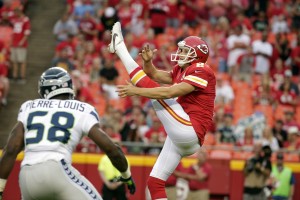
Nov. 1, 2015; London; Kansas City Chiefs punter Dustin Colquitt (2) against the Detroit Lions at Wembley Stadium. (AP Photo/Matt Dunham)
KANSAS CITY, Mo. – More than 30 years ago, the Chiefs selected punter Jim Arnold in the fifth-round of the 1983 NFL Draft.
A Georgia native who played at Vanderbilt University, Arnold was very much a man of the South. He always seemed to have a pinch of snuff in his bottom lip. Off the field he wore baseball caps from manufacturers of hunting and fishing equipment.
Arnold ended up kicking for 12 years in the league, the first three of those (1983-85) with the Chiefs. He did not stay in Kansas City because of inconsistent punting. He frequently self-diagnosed the problem and often laid blame on the fact he was dealing with gremlins, three of them, that sat on his shoulder and talked to him when things weren’t going well.
“Fear, doubt and worry – you can’t let those gremlins into your head,” Arnold said back then. “Nothing will screw up a punter more than going out to kick and having fear, doubt and worry sitting there on your shoulder as you take snap.”
These days, those gremlins are nowhere near the man who has been the Chiefs punter for the last 11 seasons. Dustin Colquitt is in the midst of maybe his finest season in Kansas City and fear, doubt and worry are now sitting on the shoulder of Chiefs opponents. The other guys are losing the field position battle each game because of Colquitt’s skills.
The NFL recognized that this week when Colquitt was named the AFC’s Special Teams Player of the Week for his performance against San Diego. This came despite the fact he averaged just a fraction over 40 yards on his five punts against the Chargers.
NFL punting is more than kicking the ball as high and far as possible. Colquitt could kick that way and rank among the league leaders. But he’s working a different path, and it’s all about helping his offense get out of a hole, and giving his defense a chance to bottle up the opposing offense.
“The punter is part of a team, and he has to punt within the team,” Colquitt said recently. “There’s a lot on the line for the offense and defense every time the punter steps on the field.”
Here are the important numbers for Colquitt after 10 games in the 2015 season:
- 48 punts for 2,218 yards, an average of 46.2 yards per punt. That average ranks him No. 11 in the league and the average is better than his career number of 44 yards.
- He’s No. 4 in net punting average, with a 42.9-yard average. Among the three punters ahead of him, two have indoor stadiums for home games.
- With 25 punts that finished inside the opponents’ 20-yard line, he’s tied for the league lead with Johnny Hekker, punter for the St. Louis Rams.
- The Chiefs are tied at No. 6 for the fewest punt returns allowed this season with 18. The NFL average is 23 and the league leader is an Arizona team that’s faced a dozen returns.
The statistics can drone on and on, but the numbers flesh out the real punting artistry of Colquitt. His ability to limit returns with his hang time, and bottle up the opponent with poor starting field position with his directional kicking.
“I think he’s the best there’s ever been, really,” special teams coordinator Dave Toub said. “When you look at it over the years, 40 percent of his kicks are inside the 20. It’s unbelievable; I don’t know if there’s anybody that’s been even close to him – maybe the guy that was at the New York Giants for years, Jeff Feagles. But I don’t think there’s anybody else closer than him (Colquitt.) He does such a great job, he’s so consistent with it, and confident.”
Feagles played for 22 seasons and 352 games in the NFL and his career punting average was just 41.6 yards. Especially during his time with the Giants, Feagles wasn’t interested in punting’s bigger number, but in the small details that make it easier for a team to win a game through all three phases: offense, defense and special teams.
Never has Colquitt’s abilities been better displayed than during the Chiefs current four-game winning streak. The Steelers, Lions, Broncos and Chargers were befuddled by his arching punts that kept giving the opponent long fields to find offensive success.
In the last four games, Colquitt has punted 17 times. He’s averaged 44.5 yards on those punts, with a net average of 42.2 yards. One of those punts was muffed (San Diego) and the Chiefs recovered the ball. The other 16 punts included nine that finished inside the 10-yard line and 11 of the 16 were stopped inside the 20-yard line. On those 17 punts, opponents gained 18 return yards.
“It’s tough to drive the length of the field each and every series,” coach Andy Reid said. “The percentages work against you.”
In last week’s 14 NFL games there were 30 possessions that started inside the offense’s 10-yard line. Touchdowns were scored on four and a field goal came on a fifth possession. Of the 30 possessions, 20 ended with a punt. Drives of 80, 90 yards are just hard to find.
Colquitt’s teammates appreciate what he provides them in taking on the opposing offense.
“When you think about it, we play a game of inches,” outside linebacker Tamba Hali said. “Any time he’s able to put the ball inside the 10, that helps our entire team, our defense, it allows us to do what we like. They’re working with such little space back there that they got to get the ball out. It’s exciting to see that.”

Aug. 21, 2015; Kansas City, MO; Chiefs punter Dustin Colquitt (2) during a preseason game against the Seattle Seahawks at Arrowhead Stadium. (AP Photo/Charlie Riedel)
Players and coaches often refer to “tipping the field” and that’s what a good punter can do. It’s not always easy to see the tipping during a game, because frequently the battle for better field position pays off several possessions after the key punt.
Take the San Diego game in Week 11 where Colquitt kicked five times. The Chargers muffed one return, and it was recovered by the Chiefs. On the four other punts, quarterback Philip Rivers and the S.D. offense began at the Chargers 1, 6, 7 and 11-yard lines. Two of those San Diego possessions inside the 10-yard line ultimately led to Kansas City’s touchdown.
It comes from Colquitt’s ability to hit punts like he’s throwing darts. Everything he does is designed to not give away any part of the field. The worst thing that can happen for Colquitt is a punt that sails into the end zone for a touchback, giving the opponent a free 20 yards.
“I hate those with a passion,” Colquitt said. “Sometimes it’s just bad luck, or one of the (cover) guys was not able to down the ball in the field of play. Based on the conditions in each stadium, I have a pretty good idea how far a ball will bounce when it hits. If I hit it the way I plan, we should be able to make a play.”
He can also affect the punt with his mechanics, from how he drops the ball to his left foot, to his follow through on the kick, to his ability to aim for what used to be called the “coffin corner”, the pylons on either side of the goal line.
“He looks at it as an art craft,” Toub said of Colquitt’s ability to pound the ball deep into opponent’s territory. “He takes pride in it. He’s so disappointed when he hits a touchback, I mean it really crushes him. He takes it upon himself to be the guy that’s going to do it, let alone having a gunner down there to make the play, too.
“When you combine it with him and the gunner being in good position, we’re going to have a high percentage of those kicks inside the 20.”
Actually for Colquitt it’s about dropping the punts inside the 10-yard line. Forcing an offense to go 90-plus yards for a touchdown is major factor in any winning formula in the NFL.
“You have to be patient as a punter, because your kick may not pay off immediately,” Colquitt said. “Sometimes the ball has to change hands a couple more times before you can see what a punt has set up.
“If the other team keeps starting drives inside the 10-yard line, or even the 20, the odds say we’ve got a better chance of getting the ball back in good position for our offense.”
———-
Bob Gretz is the senior editor for ChiefsDigest.com. Use the contact page to reach him or find him on Twitter: @BobGretzcom.
———-
